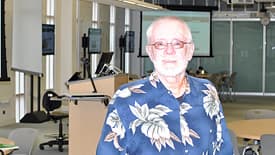Faces – Kurt Richter

From Gandy dancer to UNC Charlotte Employee of the Year could be the title of Kurt Richter’s biography.
Richter, an instructional technology specialist in the Center for Teaching and Learning, was honored earlier this year; his plaque rests within a special place inside his Kennedy Building office – his halibut/orange roughy fishing net.
Being named among the Employees of the Year was “one of the coolest experiences of my professional career,” said Richter. “I didn’t seek the recognition, but colleagues felt that what I was accomplishing was important. It’s gratifying to be honored as it’s validation that your work matters to your department and the University.”
As part of his work to help improve classroom instruction, Richter spearheaded the development of the Active Learning Academy for faculty who use the active learning classrooms in the Kennedy Building; the classrooms are based upon the N.C. Scale Up project and its researcher Bob Beichner at N.C. State University.
While active learning classrooms are in use at various college across the country, Richter organized the academy as a unique training cohort where instructors help to train each other in the use of active learning strategies.
“Sharing good instruction, making instruction better for all faculty members sets UNC Charlotte apart from other institutions using active learning classrooms,” explained Richter. “Here, there is a strong emphasis on professional development, and working with these instructors is the most exciting thing I’ve done professionally. After 40 years in education, I can say working in the Center for Teaching and Learning is the best of the best for me; it’s the best unit I’ve worked for in education anywhere.”
Following the death of his father, Richter moved to Minnesota and lived with his grandmother, who taught him in second grade. He also met his future wife Marilyn the same year.
After completing a bachelor’s degree in elementary school education, Richter realized a lifelong ambition to live and work in Alaska; he blanketed the state with resumes and obtained a teaching position.
He and his wife settled in Alaska in 1974, and he taught there until 1997. The couple built their own 4,200-square-foot home north of Fairbanks, known as the Golden Heart of Alaska. They lived about 80 miles south of the Arctic Circle and weathered temperature extremes as low as 76 degrees below zero to 108 degrees Fahrenheit.
During the academic year he taught, and in the summer, he worked numerous jobs so his wife could realize her dream to be a homemaker. The couple has two children, Katie Stein and Matt Richter who both reside in Cincinnati, Ohio.
One year, Richter was a Gandy dancer on the North Pole railroad. A slang term, Gandy dancers laid and maintained railroad tracks using long-handled spade shovels, rocking back and forth to place the wooden ties.
Other summer jobs were working on the Trans Alaska Pipeline, truck driver, home builder, real estate agent, fisherman, logger and University student teaching supervisor.
Upon retirement from public school teaching, Richter decided to pursue a doctorate in instructional systems technology at the University of Indiana, Bloomington. He stayed two additional years as a post-doctoral fellow working on a U.S. Department of Education grant “Leveraging Technology to Keep America Competitive.” He joined UNC Charlotte in April 2011.
Beyond the confines of his Kennedy Building office, Richter can be found fishing, camping or riding his Gold Wing or Magna motorcycles.
A musician at heart, Richter plays the guitar and piano, and he sings; at some point, he and his wife plan to attend music festivals across the country. Of course, he’s already been to 49 states, and in his youth, Richter did a cross-country tour traveling to Ohio and along Route 66 to California. Along the way, he and a friend would stop into Shakey’s Pizza Parlor outlets to sing.
“This was in 1969, and we’d walk in and ask the manager if we could perform,” explained Richter. “We’d get a pizza and a pitcher of beer, and we’d put out a hat for donations. We started the trip with $300 and came back home at the end of the summer with $320.”